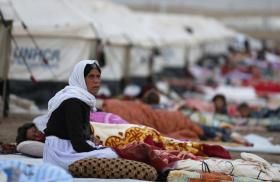

Part of a series: Counterterrorism Lecture Series
or see Part 1: U.S. Efforts against Terrorism Financing: A View from the Private Sector
An inside look at the Department of Energy's efforts to counter the threat of atomic terrorism.
On June 16, 2006, Rolf Mowatt-Larssen, director of the U.S. Department of Energy's Office of Intelligence and Counterintelligence, addressed a Washington Institute Policy Forum. The following is the prepared text of his remarks.
In 1998, Osama bin Laden said that it was an Islamic duty to acquire weapons of mass destruction, and it is through this prism that most people view the threat of nuclear terrorism. The post-9/11 successes against the Taliban in Afghanistan yielded volumes of information that changed our view of al-Qaeda's nuclear program. We learned that al-Qaeda wants weapons to use, not a program to sustain and build a stockpile, as most states would. Al-Qaeda obtained a fatwa in May 2003 from Saudi cleric Naser al-Fadh that attempted to justify the use of weapons of mass destruction. Moreover, al-Qaeda spokesman Suleyman abu Ghayth said in 2003 that it is al-Qaeda's right to kill 4 million Americans in retaliation for Muslim deaths that al-Qaeda blames on the United States. In January 2006, bin Laden threatened that "operations are being prepared and you will see them in your own backyard," and past experience strongly suggests that they will strive to conduct an attack more spectacular than 9/11. Based on such information, most people would agree that al-Qaeda personifies today's nuclear terrorism threat.
It would be a mistake, however, to view nuclear terrorism strictly through the prism of the threat posed by al-Qaeda today. Taking this view leads to a simplistic solution -- if we prevent al-Qaeda from acquiring a nuclear capability, we eliminate the threat. As important as this is, the sober reality is that the threat posed by nuclear terrorism is much broader than the aspirations of any single terrorist group. We live in a world of escalating levels of asymmetric vulnerabilities. Increasing numbers of disaffected groups are turning to violence to achieve their goals. When the first suicide bombers attacked the Iraqi Embassy in Beirut in 1981, no one at the time imagined a day when suicide attacks against civilians would become commonplace. The extremes of 20 years ago are no longer extreme, and we must guard against any conventional thinking that places limits on the art of the possible for terrorist action. It is precisely the potential to surprise, along with the asymmetric impact of weapons of mass destruction that makes them appealing to the desperate designs of terrorists. Thus, it is not difficult in today's world to imagine an escalation of stakes to the ultra-violence represented by unleashing a nuclear attack on the world.
We continue to face the enduring consequences of letting the nuclear genie out of the bottle. The power of the atom has become one of the most highly sought after prizes of twenty-first century technological advancement. States want to harness its power for energy, weapons, deterrence, and prestige. Substate actors desire it for the asymmetric power of becoming a state, at least in terms of the influence they are able to wield. Nuclear terrorism therefore is not a single-point issue but a strategic problem that will continue to grow in significance throughout the twenty-first century. To meet this threat, we must make a strategic shift from our traditional views of terrorism, proliferation, nuclear weapons, and nuclear energy as being separate entities and instead view them as parts of a single framework of all things nuclear.
Within the framework of all things nuclear, it is increasingly difficult to draw traditional distinctions between a state that possesses nuclear weapons and a state that could possess nuclear weapons if it chose to take that path. Nearly any modern industrial state has the ability to develop the technological infrastructure or illicitly acquire the specific components required to build a nuclear weapon. Nuclear weapons can range from the sophistication of a state weapon, designed to detonate only where and when the state chooses, to a crude, simple device produced by a developing nation or a determined non-state actor. We should not assume that the technology of a nuclear weapon is beyond the capability of a terrorist group or developing country. The early nuclear weapons developed in the United States, United Kingdom, France, the Soviet Union, and China used technology that, while advanced in its time, is now largely commercially available. In assessing the capability of states and groups to make good on their nuclear intent, we must consider the possibility of collaboration between states, states and groups, and as the AQ Khan network revealed, between rogue networks and customers willing to pay for their services.
The technological expertise needed to develop an improvised nuclear device is spreading. Already, nearly 280 small-scale nuclear research reactors exist in 56 countries around the world. According to a recent article in the Washington Post, nearly 40 nations have approached the UN's International Atomic Energy Agency (IAEA) stating their interest in starting civil nuclear power programs, and nearly a dozen have indicated a desire to conduct enrichment or reprocessing of nuclear fuels. The expertise required to support a research reactor or a nuclear power reactor infrastructure is a valuable international commodity. It is a scientific enabler and a measure of prestige in a world increasingly driven by technological innovation.
IAEA General Director Mohammad El Baradei has referred to the idea of a "latent nuclear capability," in which a state develops the necessary capability to become a nuclear power, even if it never takes the final step of building a weapon. Traditional definitions of a nuclear weapons state implied that the country had weaponized their nuclear materials onto a strategic means of delivery, such as a cruise missile or rocket. In the twenty-first century paradigm of a single threat spectrum consisting of state and sub-state actors seeking a nuclear capability, distinctions in the degree of sophistication of a weapon should no longer be the decisive threshold in our assessment of the threat.
There is however a guiding light that shines across the dim pathways of the nuclear terrorism problem: it is impossible to build a nuclear weapon without nuclear materials. Seizures of enriched uranium and plutonium from the hands of smugglers over the past fifteen years illustrate the possibility that a state or group could side-step the technological hurdles of producing their own materials and simply buy what they need from insiders diverting these materials from a state program and transferring them -- either for profit or ideological motivation -- to a third party. Current worldwide stockpiles of nuclear materials exceed hundreds of metric tons. Global efforts to secure nuclear materials make a vital contribution to reducing the threat, but it would be an illusion to believe that we can construct a perfect defense to safeguard the security of all materials. And while we must continue our work toward improving materials security and reducing levels of nuclear materials stocks, we must also urgently intensify efforts to acquire any materials that may be for sale on the illicit nuclear market, and discourage smugglers from dealing in nuclear materials.
In terms of our response, the cornerstone of adopting an all things nuclear approach is the recognition that nuclear terrorism - and efforts to combat it - is so complex that we must dedicate an authoritative structure that accounts for the interdependencies that exist within U.S. nuclear efforts in weapons, proliferation, terrorism, and energy. Such a systems approach considers no single component or organization independent of the others, emphasizes the need to continuously assess how developments in one nuclear field would create implications in others, and enables us to recalibrate the threat accordingly. It would lead to comprehensive action, valuable resources would be more efficiently utilized, and intergovernmental efforts would be less fragmented.
The threat possibilities presented by an interconnected system of intent, materials, technology, and capability bridge every stovepipe that exists in the U.S. government. This reality challenges us to constantly evaluate our methodology for monitoring and assessing how a change in any one of these factors impacts the others. For instance, for each new country that develops a civil nuclear program, we should reevaluate that country's leadership intent, its technology base, security practices, economic and social standing, and tradition of law and order and then reformulate our own nuclear, economic, technology, political, and deterrence policies in response.
Much work has been done since 9/11, but there is much left to do. The key challenge before us is to broaden our current effort into an enduring, strategic response that incorporates the following issues, among others:
The continuing instances of trafficking in nuclear materials mean we collectively have not done enough to keep material out of the hands of terrorists. We must take urgent action to scoop up any nuclear material outside state control before terrorists do. Long term, we must strengthen international legal and law enforcement efforts to make the costs of trafficking in nuclear materials so prohibitive that smugglers are deterred from participating in the trade.
The threat of terrorist use of weapons of mass destruction requires that we fundamentally elevate the level of our engagement with all nuclear powers to secure material globally, as well as raise our game in the arena of international intelligence and law enforcement cooperation. We can and must deter nuclear terrorism. We should engage the "hearts and minds" of people in all corners of the globe in order to counter the myth that the escalation of violence to a nuclear level is justifiable under any circumstances. We must communicate the plain truth that there will be no winners in a world transformed by a terrorist mushroom cloud. We should rethink the traditional elements of nuclear doctrine to encompass the complex matrix of state and sub-state actors in continuously evolving states of intent, acquisition of expertise, capability, and material.
In conclusion, the world will be confronted by the nuclear genie in his malevolent forms for the foreseeable future. We must adapt our intelligence and policy efforts to confront the threat along its entire continuum in a persistent, sustained manner. It must be a global effort incorporating police, intelligence services, militaries, government agencies and ministries, and citizens across the world. The effort will require broad and often unprecedented information sharing across every front -- between government and private sector, and among foreign partners, including those who were once our adversaries. And we must take a systems approach that is able to monitor and adjust to fluctuations in all things nuclear across the globe.





